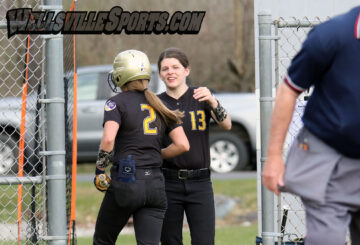By Chuck Wiser, I write the words to share what my eyes see and my heart feels
I’ve spent a fair amount of time on the road the past few weeks Wrambling through many municipalities to multiple places for various reasons. In my travels I often see signs that say: “Village of…” or “Any-name Township.” As I began to write this week’s offering, I decided to discuss that, thinking it would be a fairly short, no-brainer topic. As I started to write I was going to introduce my hometown, formerly known as the hamlet of Nile, included in the Town of Friendship. I immediately ran into snags, and once again became immersed in learning far more than anticipated.
My topic, as a whole, was to be to describe the differences between municipalities, by their geographic names such as: Hamlets, Villages, Towns, Cities etc. I wasn’t even going to include the “burgs” like Hamburg or the “burbs,” as in suburbs. Wanting to be precise, and to be correct in my definition of Friendship as a Town. My Google search for Friendship stymied me. What appeared from Wikipedia was the statement to the effect that: Friendship, the hamlet, is a “former village that dissolved its municipal corporation in 1977. That wasn’t to be the main focus of my Wrambling so I will leave that one alone for now.
When I did a similar search for Nile, the only link I could find was a brief mention of it in a History of Friendship, NY. Publication. Locally, at least, it is designated a “hamlet”, but I have yet to find verification of that so will skip the technicalities for now.
My anecdotal recollection of the municipality “terms” included that a city had to have more than 5000 residents. I couldn’t find any validation of that anywhere, and as it turns out the geographic designations vary from State to State and are outlined in various census reports. The Census Bureau listing for each of a few States shows quite a discrepancy.
Louisiana: City: Minimum population requirement of 5,000. Town: Minimum population requirement of 1,000. Village: Minimum population requirement of 300
New York: City: Incorporation is by special act of the State legislature; there is no minimum population requirement. Village: Minimum population requirement of 500 and must have a population density of ≥ 100 people per square mile.
Alabama: City: Minimum population requirement of 2,000. Town Minimum population requirement of 300;
Nebraska: City: Minimum population requirement of 800. Village Minimum population requirement of 100
Virginia: City: Minimum population requirement of 5,000. Town Minimum population requirement of 1,000
Alabama: City: Minimum population requirement of 2,000. Town Minimum population requirement of 300; territory located in Jefferson County, or within 3 miles of an incorporated area, requires a population ≥ 1,000 to incorporate; territory in Jefferson County and within 3 miles of an incorporated area requires ≥ 10,000 people to incorporate.
Arkansas City: Minimum population requirement of 500. Town: Must have ≥ 20 qualified voters to incorporate.
As you can see, there is no real universal standard and much deviation. No Hamlets were injured in this reporting.
My main topic was going to be on Words, and that somehow morphed into the differences between the geographic terms/words town versus city, and it took off from there.
Staying with “words”, and even municipalities as a topic, I recently heard the phrase popularized most recently, albeit several years ago, by a prominent politician who started out as a wife and ended up a candidate as well; “It Takes a village to raise a child.” Looking up that phrase knowing it was a quote, its history is: “it takes a village to raise a child” originates from an African proverb and conveys the message that it takes many people (“the village”) to provide a safe, healthy environment for children, where children are given the security they need to develop and flourish, and to be able to realize their hopes and dreams” (Note: Last word was my addition).
How do you pronounce the state name “Illinois”? That is one of the many puzzling words which spelling defies grammatical rules and norms in that it takes a different language’s phonetic standard to properly pronounce it. If I recall correctly, the proper pronunciation ends with the “nois” suffix pronounced as if it ends with a “oy” as in toy, or boy, and not as is pronounced with the word “noise”. Oh, the wonder of our language. No wonder we wonder as to its wonder.
My latest visit to Runnings last week left me with a smile and warm feeling that lasted the rest of the entire day and rekindles still with the recall. To venture forth that day I sported my recent Christmas present Buffalo Bills vest. As I was on my way in, an elderly couple, I dare say well into their 80’s, paused in front of me and the lady pointed to my vest and exclaimed that she loved the vest. She went on to explain what great fans they were of the Bills and cited numerous plays made and called by the various players in a recent game. The presumed husband’s job was to stand behind the lady and nod in agreement with everything she had to say. We chatted for quite awhile before they had to venture on their way.
As long as I’m on a roll with words I might as well continue. Have you wondered why different, but yet similar, words have different prefixes and suffixes. There must be a specific technical reasoning based on the meaning or use of the word, or its origin. Often times the background is obvious or self-explanatory. Why is a person that studies History a historian or that takes care of the Library a librarian, when a person who studies Science a scientist, or Biology a biologist?
So far, we have been lucky to have escaped any drastic or even significant snowfall. During an otherwise peaceful winter’s night a few years ago, I sat by my window watching the snow fall. It inspired the following poem. Me-thinks that the interaction of human emotion and of the activity or changes in weather around us are the two most significant poetry evoking driving forces.
I leave you with a reminder of the beauty that often surrounds us, especially at this time of the year.
Can You See The Beauty
As I look out this moonlit night
I see the snowflakes in their flight.
They could not wait till past midnight,
To start their coat upon us white.
Midnight has passed, the sky is clear.
As oft it is this time of year,
The snow that comes which we all fear
Will be so silent, we won’t hear.
The snow still falls throughout the day,
Soft to the earth it finds its way.
This time of year, twill likely stay,
So joyous children can in it play.
As darkness now obscures the sky
And snow clouds linger still on high.
The moon’s eclipse won’t reach the eye,
But still the snowflakes to us fly.
As I look out with dawns first light
Snowflake’s Blanket, pure and bright
This peaceful scene’s inspiring sight
Serenity, just feels so right.







